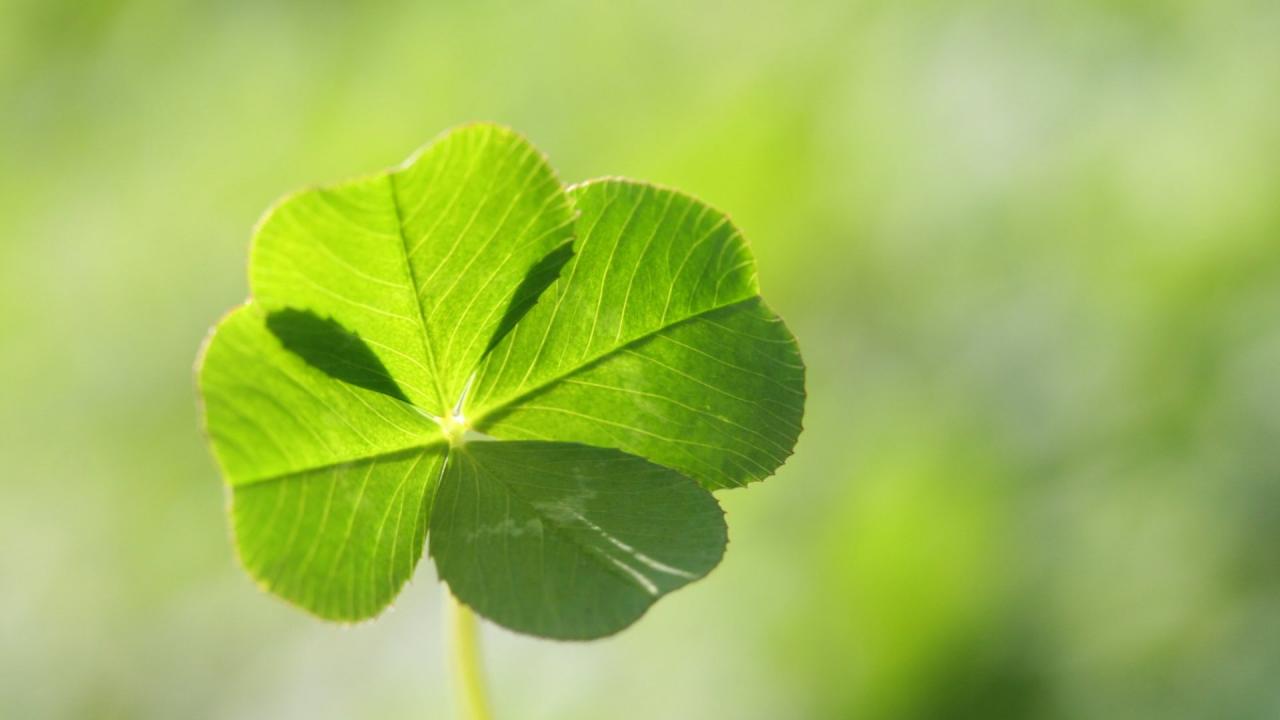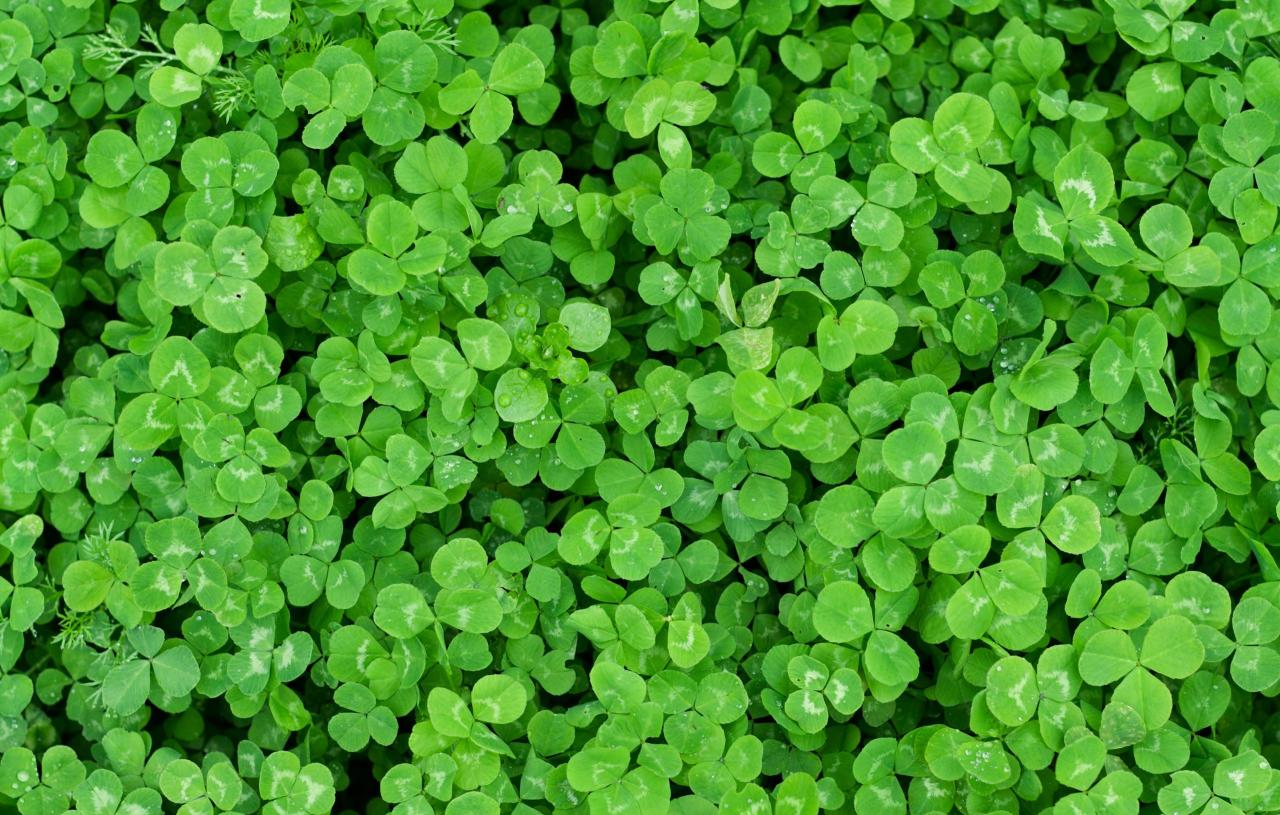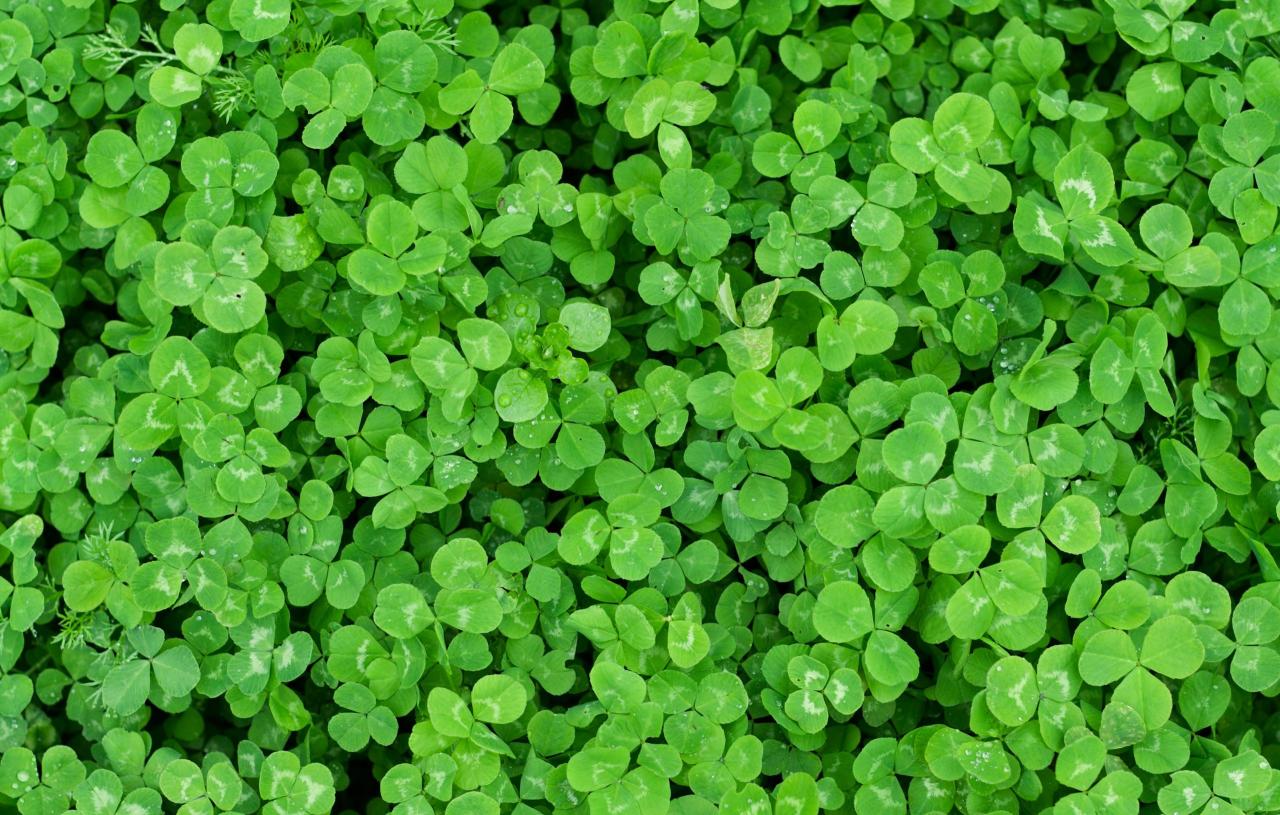How to Grow a Four Leaf Clover and Experience the Magic of Good Luck – the very phrase evokes a sense of wonder and the promise of good fortune. For centuries, the four-leaf clover has been a symbol of luck and prosperity, a lucky charm sought after by those hoping to attract good fortune.
But beyond the folklore and superstition, there’s a fascinating science behind this unique botanical anomaly.
This guide delves into the world of four-leaf clovers, unraveling the mystery behind their rarity and exploring the methods for cultivating them. We’ll uncover the genetic mutation that gives rise to this lucky charm, understand the environmental factors that influence its growth, and learn practical techniques for enhancing your chances of finding one.
The Legend and Lore of the Four-Leaf Clover

The four-leaf clover, a rare and cherished variant of the common three-leaf clover, has been steeped in folklore and superstition for centuries. Its rarity and association with good luck have made it a symbol of hope, fortune, and even magic across cultures.
Origin of the Four-Leaf Clover Legend
The legend of the four-leaf clover likely originated from ancient Celtic beliefs. In Celtic mythology, the four leaves were believed to represent faith, hope, love, and luck. The four-leaf clover was also associated with the druids, who believed it possessed magical properties and could ward off evil spirits.
While searching for that elusive four-leaf clover, you might stumble upon another captivating plant, the columbine. These delicate flowers add a touch of whimsy to any garden, but they can sometimes need a boost. If your columbines are looking a bit lackluster, check out this guide on How to Revitalize Your Columbine Plants Quickly and Effectively for tips on bringing them back to life.
Once your garden is blooming with vibrant colors, you can resume your search for that lucky four-leaf clover, knowing your green thumb is working its magic.
Popular Beliefs and Superstitions
Finding a four-leaf clover is widely believed to bring good luck. This belief is rooted in the rarity of the four-leaf clover, with estimates suggesting that only one in 10,000 clovers grows with four leaves. The association with luck is further reinforced by various superstitions, including:
- Carrying a four-leaf clover in your pocket or wallet will bring good fortune.
- Placing a four-leaf clover under your pillow will ensure pleasant dreams.
- Giving a four-leaf clover to someone you love will strengthen your bond.
Historical and Cultural Significance
The four-leaf clover has held cultural significance across different societies throughout history. In Ireland, the four-leaf clover is a national symbol and is often associated with St. Patrick’s Day. In Victorian England, four-leaf clovers were popular motifs in jewelry and fashion, symbolizing love and good fortune.
“The four-leaf clover is a symbol of hope, luck, and faith. It is a reminder that even in the face of adversity, there is always something to be grateful for.”
Unknown
Understanding the Science Behind the Four-Leaf Clover
The four-leaf clover, a symbol of good luck and a source of fascination, is a genetic anomaly that occurs in the common white clover (Trifolium repens). While most clovers have three leaves, the four-leaf clover arises from a mutation in the plant’s genetic code, resulting in an extra leaflet.
Genetic Mutation
The development of a four-leaf clover is attributed to a mutation in the plant’s genes, specifically in the genes responsible for leaf development. These mutations are random and can occur due to various factors, including environmental stress, exposure to radiation, or even spontaneous errors during DNA replication.
The exact genetic mechanisms behind the four-leaf clover mutation are still being studied, but researchers have identified several genes that are likely involved.
Rarity of Four-Leaf Clovers, How to Grow a Four Leaf Clover and Experience the Magic of Good Luck
Four-leaf clovers are rare compared to their three-leaf counterparts. The probability of finding a four-leaf clover is estimated to be around 1 in 10,000. This rarity is attributed to the fact that the mutation responsible for the extra leaflet is recessive.
This means that both parents must carry the mutated gene for their offspring to inherit the four-leaf trait.
Factors Influencing the Occurrence of Four-Leaf Clovers
While the mutation itself is random, certain factors can influence the occurrence of four-leaf clovers.
- Environmental Stress:Environmental stress, such as drought, extreme temperatures, or nutrient deficiency, can increase the rate of mutations in plants. These stressful conditions can trigger DNA damage, leading to mutations in the genes responsible for leaf development.
- Heredity:The probability of finding a four-leaf clover is higher in areas where four-leaf clovers have been found in the past. This suggests that the mutation can be passed down through generations, increasing the likelihood of finding four-leaf clovers in certain locations.
- Variety of Clover:Certain varieties of clover are more prone to producing four-leaf clovers than others. For example, the ‘Lucky Clover’ variety is known to have a higher frequency of four-leaf clovers.
Methods for Cultivating Four-Leaf Clovers
Cultivating four-leaf clovers requires understanding the right techniques and conditions for successful growth. While the four-leaf clover is a genetic mutation, creating the right environment can increase the chances of finding them.
Soil Conditions
The ideal soil for growing four-leaf clovers is a well-drained, fertile, and slightly acidic soil with a pH between 6.0 and 6.5. This ensures proper root development and nutrient absorption.
Watering
Consistent watering is crucial. Four-leaf clovers thrive in moist soil but are susceptible to root rot if overwatered. Water regularly, allowing the top layer of soil to dry slightly between waterings.
Sunlight
Four-leaf clovers prefer partial shade to full sun. Six to eight hours of sunlight per day is optimal. Excessive sunlight can scorch the leaves, while insufficient sunlight can hinder growth.
Clover Species
Selecting the right clover species is crucial for successful cultivation. The most common species for four-leaf clovers are:
- White Clover (Trifolium repens):This species is commonly found in lawns and is known for its fast growth and tolerance to various conditions.
- Red Clover (Trifolium pratense):This species is larger than white clover and produces distinctive red flower heads. It’s known for its ability to attract beneficial insects.
- Crimson Clover (Trifolium incarnatum):This species has striking crimson flower heads and is often used as a cover crop. It’s known for its ability to fix nitrogen in the soil.
Techniques for Growing Four-Leaf Clovers
Several techniques can be used to increase the chances of finding four-leaf clovers.
- Seed Selection:Choose clover seeds specifically bred for four-leaf mutations. While not guaranteed, these seeds have a higher chance of producing four-leaf clovers.
- Regular Mowing:Mowing regularly encourages the clover to produce new growth, increasing the chances of finding four-leaf clovers. Maintain a height of about 2-3 inches.
- Fertilizing:Regular fertilizing provides essential nutrients for healthy growth, increasing the chances of four-leaf mutations. Use a balanced fertilizer suitable for clovers.
- Stress Induction:Creating controlled stress, such as mild drought or slight nutrient deficiency, can trigger genetic mutations, potentially increasing the chance of finding four-leaf clovers. However, be cautious as excessive stress can harm the plants.
Enhancing the Chances of Finding a Four-Leaf Clover

While the occurrence of a four-leaf clover is a rare genetic mutation, there are specific strategies and locations that can increase your odds of finding one. By understanding the factors that influence their growth and applying these tips, you can embark on a successful hunt for this lucky charm.
Identifying Prime Locations for Four-Leaf Clovers
The presence of four-leaf clovers is influenced by various environmental factors, including sunlight, soil conditions, and competition from other plants. By seeking out areas that are conducive to their growth, you can increase your chances of finding these rare specimens.
- Areas with Moderate Sunlight:Four-leaf clovers thrive in partially shaded areas that receive some sunlight but are not exposed to direct sunlight for prolonged periods. These conditions promote healthy growth without stressing the plants.
- Moist and Well-Drained Soil:The ideal soil for four-leaf clovers is moist but well-drained, allowing for adequate water retention without becoming waterlogged. Clayey soils with high organic matter content are particularly suitable.
- Disturbed Areas:Areas that have been recently disturbed, such as mowed lawns or freshly tilled gardens, often experience an increase in the occurrence of four-leaf clovers. The disturbance can disrupt the plant’s growth patterns, increasing the chances of mutations.
- Pastures and Meadows:Pastures and meadows with a diverse range of clover species provide ample opportunities for finding four-leaf clovers. These areas often have a mix of clover types, increasing the likelihood of encountering a mutation.
Tips and Tricks for Increasing the Odds of Finding a Four-Leaf Clover
The search for a four-leaf clover can be a fun and rewarding experience. Here are some tips to increase your chances of success:
- Focus on the Edges:Four-leaf clovers are often found on the edges of lawns, meadows, or pastures where there is less competition from other plants. These areas receive more sunlight and nutrients.
- Scan in a Zigzag Pattern:Avoid looking at each clover individually; instead, scan the area in a zigzag pattern, allowing your eyes to cover a wider range quickly.
- Look for Dense Clover Patches:Focus on areas with dense patches of clover. The higher the density, the greater the chances of encountering a mutation.
- Utilize a Magnifying Glass:A magnifying glass can help you see the details of each clover more clearly, making it easier to spot a four-leaf clover amidst the three-leaf varieties.
- Practice Patience:Finding a four-leaf clover requires patience and perseverance. Don’t give up after a short search; keep exploring and you’ll be rewarded for your efforts.
Visual Guide to Identifying a Four-Leaf Clover
The characteristics of a four-leaf clover are distinct and can be easily identified once you know what to look for. Here’s a visual guide to help you distinguish a four-leaf clover from its three-leaf counterpart:
Four-Leaf Clover Characteristics:
- Four distinct leaflets arranged in a cross shape.
- Each leaflet is typically heart-shaped or oval.
- The leaves are usually green, but can sometimes have variations in color.
- The stem is thin and delicate, connecting the leaves to the root.
The Symbolism and Meaning of the Four-Leaf Clover
The four-leaf clover, a rare mutation of the common three-leaf clover, holds a significant place in folklore and culture as a symbol of luck and fortune. This seemingly ordinary plant has captivated the imaginations of people across the globe, becoming a ubiquitous representation of good fortune and prosperity.
Cultural Interpretations and Meanings
The four-leaf clover’s symbolism varies across cultures and traditions, reflecting the diverse beliefs and interpretations surrounding its rarity and perceived magical qualities.
- Celtic Tradition:In Celtic mythology, the four-leaf clover was associated with the four elements: earth, air, fire, and water. It was believed to offer protection against evil spirits and grant access to hidden knowledge.
- Christian Tradition:Some Christian interpretations link the four leaves to the four Gospels: Matthew, Mark, Luke, and John. This association further strengthens the four-leaf clover’s symbolism of faith and divine guidance.
- Irish Culture:The four-leaf clover is deeply intertwined with Irish folklore and national identity. It is often associated with St. Patrick, who is said to have used the three-leaf clover to explain the Holy Trinity, and the four-leaf clover became a symbol of Ireland’s faith and cultural heritage.
- General Belief:In many cultures, finding a four-leaf clover is considered a sign of good luck, signifying fortune, prosperity, and happiness. This belief has transcended cultural boundaries and remains popular across the globe.
Comparison with Other Lucky Charms
The four-leaf clover shares a common thread with other lucky charms, each representing a different aspect of fortune and good fortune.
Lucky Charm |
Symbolism |
Cultural Association |
|---|---|---|
Four-Leaf Clover |
Luck, fortune, prosperity, faith, protection |
Celtic, Christian, Irish |
Horseshoe |
Good luck, protection, prosperity |
Various cultures, particularly European |
Rabbit’s Foot |
Good luck, protection, fertility |
Various cultures, particularly African American |
Ladybug |
Good luck, happiness, prosperity |
Various cultures, particularly European and Asian |
The Practical Applications of Four-Leaf Clover
Beyond their symbolic significance, four-leaf clovers possess a captivating charm that has inspired numerous practical applications in crafts, decorations, and creative endeavors. Their unique appearance and association with good luck make them a sought-after element in various artistic expressions and personal designs.
Incorporating Four-Leaf Clovers into Crafts and Decorations
The delicate beauty of four-leaf clovers makes them an ideal addition to various craft projects. They can be pressed and dried to create unique bookmarks, pressed flower art, or incorporated into resin jewelry. Their small size and intricate shape lend themselves well to decoupage techniques, where they can be adhered to surfaces like boxes, trays, or picture frames.
Four-Leaf Clovers in Jewelry and Fashion
Four-leaf clover motifs are widely used in jewelry design, symbolizing good luck and fortune. These motifs are often incorporated into necklaces, bracelets, earrings, and rings, crafted from various materials like silver, gold, or even precious stones. The clover’s four leaves can also be depicted in intricate designs on clothing, such as t-shirts, scarves, or dresses, adding a touch of whimsy and good luck to everyday attire.
Four-Leaf Clover Motifs in Home Décor
The symbolism and aesthetic appeal of four-leaf clovers have made them a popular choice for home décor. They can be featured in various forms, such as framed prints, wall decals, or decorative throw pillows. The clover’s delicate green color adds a touch of nature and serenity to any space.
While finding a four-leaf clover is often attributed to luck, cultivating them requires a bit more than just wishing. Understanding the optimal conditions for clover growth is key, and that’s where Rodgers Plant Growth: Expert Tips for Maximum Results comes in.
By applying these expert tips, you can create the ideal environment for your clover patch, increasing your chances of finding that elusive four-leaf clover and experiencing the magic of good luck firsthand.
Four-Leaf Clover in Artistic Expressions and Personal Designs
Four-leaf clovers serve as inspiration for various artistic expressions, from paintings and drawings to sculptures and digital art. Artists often use the clover’s shape and symbolism to convey messages of luck, hope, and prosperity. The clover’s unique structure also makes it a popular subject for photography and macro photography, capturing its intricate details and delicate beauty.
Examples of Four-Leaf Clover in Creative Projects
“The four-leaf clover is a symbol of good luck, and its unique appearance makes it a popular choice for jewelry, clothing, and home décor.”
For example, a renowned jewelry designer, [designer’s name], has created a line of necklaces featuring four-leaf clover pendants crafted from recycled silver, highlighting the environmental sustainability of the design. Similarly, a renowned fashion house, [fashion house name], incorporated four-leaf clover motifs into their latest collection of silk scarves, adding a touch of whimsy and good luck to their designs.
Conclusion
Whether you’re a believer in the magic of the four-leaf clover or simply fascinated by the botanical marvel, the journey to cultivating your own lucky charm is an enriching experience. It’s a testament to the power of nature, a reminder that even the most unlikely of occurrences can be nurtured and encouraged.
So, get ready to embark on a quest for good luck, one leaf at a time.
Essential Questionnaire: How To Grow A Four Leaf Clover And Experience The Magic Of Good Luck
Is it possible to grow four-leaf clovers intentionally?
While you can’t guarantee a four-leaf clover will sprout, you can create an environment that encourages their growth by using the right techniques and selecting the appropriate clover species.
How rare are four-leaf clovers?
The odds of finding a four-leaf clover are estimated to be about 1 in 10,000. This rarity contributes to their association with luck and fortune.
What are the best clover species for growing four-leaf clovers?
White clover (Trifolium repens) is a common choice, but other species like red clover (Trifolium pratense) can also produce four-leaf variants.
Can I find four-leaf clovers in specific locations?
While finding a four-leaf clover is largely a matter of chance, they are more likely to occur in areas with rich, fertile soil, adequate sunlight, and consistent moisture.
What is the best time of year to search for four-leaf clovers?
Spring and summer are generally the best times to search for four-leaf clovers, as they are actively growing during these seasons.
